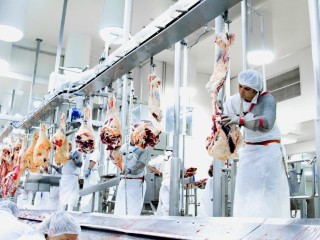 Despite another rise in over-the hooks slaughter rates towards the end of last week, the shortage of killable cattle across Eastern Australia was again evident when the national seven-day kill to Friday declined 2 percent to 125,944 head.
Despite another rise in over-the hooks slaughter rates towards the end of last week, the shortage of killable cattle across Eastern Australia was again evident when the national seven-day kill to Friday declined 2 percent to 125,944 head.
On top of earlier price rises, the 5-7c/kg lift in rates on many process cattle is more likely to be seen in the current week’s slaughter results, stakeholders say, although the slow response to anticipated increases in kill numbers over the past fortnight has some onlookers a little perplexed.
That’s especially so, given that last week showed little evidence of wet weather disruptions that hampered cattle movements in south-eastern Australia a week earlier.
Data released this afternoon by NLRS showed Queensland’s weekly kill to Friday virtually unchanged at 69,696 head, still 2pc better than the same week last year.
Major Queensland plants plan to complete all scheduled shifts again this week, staff say.
Slaughter cattle flows out of Queensland’s channel country are now reaching their peak, with one estimate suggesting weekly turnoff into all Queensland export plants could currently be around 15,000 head. Better road accessibility in the far west, after earlier periods where access was still impacted by boggy conditions, is one reason.
Barring early spring rain disruptions, those channel country cattle are likely to continue unabated until well into November, pastoral company sources said this week. While the heaviest of the channel country bullocks were in many cases turned-off earlier in the season, weights are still very solid, by historic standards, reflecting the region’s big summer 2010 season.
Offsetting that, there has been a distinct absence of oats cattle in southern Queensland plants this year, as producers took advantage of good moisture profiles to plant a winter grain crop, rather than forage crops for cattle. The trend was first picked up on Beef Central “Oats plantings limited despite big rainfall” on June 24.
Northwestern and central western Queensland grass-finished cattle are providing a substantial component of the current Queensland kills.
One trend which has not been seen yet this spring season, however, is the flow of southern-state stock into southeast Queensland plants. If anything, the cattle movement is currently in the opposite direction, one stakeholder said.
That trend could reverse once supplies out of cattle regions in Queensland are exhausted, however, but profitability on shifting slaughter cattle longer distances out of southern Australia into southern Queensland will determine how extensive the trend is this year.
Slaughter activity in southern states was much more patchy last week, despite better weather conditions.
Numbers in NSW eased 1pc to 32,014 head, as major plants returned to normal shifts, although cattle numbers remained light through saleyards last week.
Victoria’s kill declined substantially, down 7pc to 15,376 head, a full 20pc below the same week last year as the shortage of stock took effect. The kill for all species in Victoria slumped last week, with sheep kill down 31pc on the back of a dramatic mutton price decline, in places back $20-$40 a head, and lamb kill back 8pc to 125,923.
South Australia’s adult beef kill of 6755 head also reflected the tight supply situation, with Teys Naracoorte skipping Monday’s kill based on limited stock access.
Tasmania’s kill of 2103 head represented a 12pc rise, due mainly to seasonal plant closures a week earlier. JBS’s King Island factory closed for maintenance and the company’s Longford facility also had a reduced tally. A week’s closure at Greenham’s Smithton plant is likely to be reflected in figures for this current week.
The Eastern States Young Cattle Indicator closed yesterday at 399c/kg, up 7.25c on the same time last week, and a rise of 12c in a fortnight.
The indicator has only exceeded the magic 400c/kg mark twice before in history. It happened during 2005 at the height of the international market disruption caused by bans on US exports to key markets due to BSE issues, and again during a six-week period from mid-March this year during a period when the A$ currency value was closer to parity with the US$ and international demand was high.
